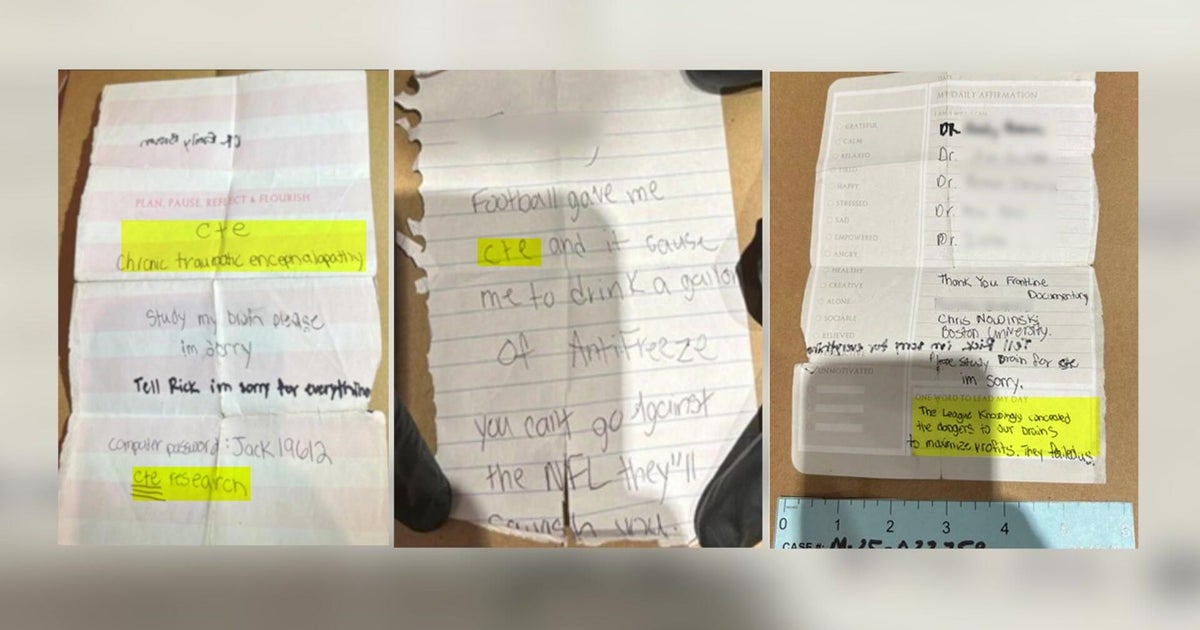In July, a mass shooting at a Midtown office building shocked New York City. Aland Etienne, Wesley LePatner, Julia Hyman and NYPD Det. Didraul Islam were all killed by Shane Tamura, a 27-year-old former high school football player.
Tamura then shot himself in the chest. In handwritten notes he left behind, Tamura repeatedly referenced CTE and said, “Study my brain please. I’m sorry.”
CTE is a degenerative brain disease linked to repeated head trauma that is often found in football players. It can only be diagnosed definitively after death.
Two months later, the medical examiner is still analyzing Tamura’s brain, but what will it reveal?
Shooter targeted NFL offices
In Tamura’s final note, he scribbled the name of Chris Nowinski, a leading CTE expert.
Nowinski is a former college football star and pro-wrestler turned neuroscientist. After a career-ending concussion at the WWE, he co-founded the nonprofit Concussion Legacy Foundation, which has helped study more than 1,700 donated brains.
“I’ve spent the last 20 years of my life trying to raise awareness of CTE,” Nowinski said. “Part of the message that we’re trying to reach football players with is, it can be the cause of what you’re going through, and seek help and care is available. And I wish that [Tamura] heard that message.”
Police say Tamura was targeting the offices of the NFL. He wrote, “The League knowingly concealed the dangers to our brains to maximize profits.”
In the wake of the shooting, the NFL released a statement of support for the victims of the shooting and their families. The League hasn’t addressed the shooter’s CTE claims.
“The NFL does acknowledge CTE and will tell you the 100 things they’re doing to try to prevent it,” Nowinski said.
CBS News New York reached out to the NFL to see if there’s anything they wanted to add. We have not yet heard back.
“It is killing you cell by cell”
Football players sustain thousands of hits to the head. Nowinski says studies show about one-third of football players who stopped playing after high school but died before age 30 had CTE. He says it is not inevitable, but if you’re hit again and again, that repeated exposure massively increases risk.
“The most likely place it shows up in everybody at the beginning is the dorsolateral prefrontal cortex, so … behind the forehead, basically with the idea that when your brain twists violently, that part of your brain is moving the most,” Nowinski said.
The disease physically changes a person’s brain, Nowinski explained.
“It is killing you cell by cell. When you lose enough neurons in certain places, you will change as a person,” he said.
CTE doesn’t always make a person more aggressive or violent, however, Nowinski said.
“Sometimes people become more apathetic,” he said.
The city’s chief medical examiner is analyzing Tamura’s brain and conducting a neuropathological workup. Results are expected imminently.
“Whatever’s in his brain is never going to be the reason for what happened”
Tamura’s family had long warned he suffered from migraines, mental illness and multiple sports concussions.
In 2023, Tamura was arrested for trespass after a dispute at a Las Vegas casino. In two other episodes, his mother called 911 to report he was suicidal.
In audio from one of those 911 calls in 2024, his mother tells the dispatcher, “He was just crying and said, ‘I’m not going to be able to go any further.'”
Despite what the medical examiner concludes, Nowinski says no finding can explain a single violent episode.
“Whatever’s in his brain is never going to be the reason for what happened. Human behavior is far too complex for that,” he said.
Still, Nowinski says hits to the head come with a cost.
“We’ve known for a very long time that one traumatic brain injury can increase your risk of developing bipolar disorder. It can increase your risk of having schizophrenia diagnosis later in life,” he said. “Shane Tamura should not have started getting hit in the head hundreds of times at 6 years old. He just shouldn’t have, and we shouldn’t do that to kids today.”
Nowinski says reforms instituted by the NFL haven’t been instituted in youth sports.
“Every time you meet a young athlete, they don’t understand that CTE is not concussions. It’s number and strength of head impacts,” he said. “We’ve convinced a generation of men, multiple generations of men, that it’s normal to get hit in the head 10,000 times, and I’m one of those people. Now I look at it as a 46-year-old man going, that was insane.”
He tells parents and young athletes prevention is key. You never want to take lots of hits to the head, but he says it’s especially consequential before the age of 14 when the brain is still developing.
More from CBS News
